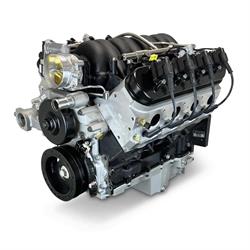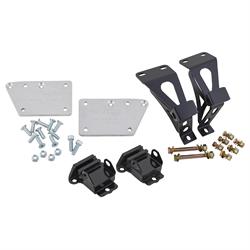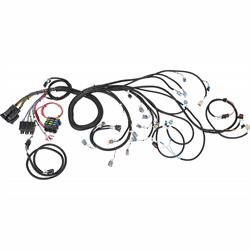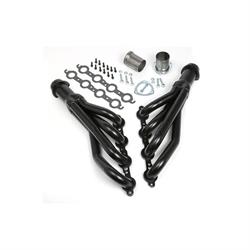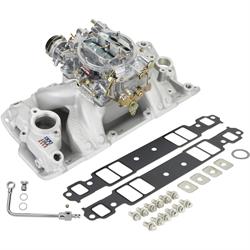SBC vs LS Showdown | Dimensions for Swaps, Weight, HP, Specs
What’s the Difference Between an SBC and an LS Engine?
With over 100 million engines made since its introduction in 1955 in the Corvette and Bel Air, the small block Chevy is arguably the longest running small block V8 engine ever produced. In the over seven decades of production there have been numerous displacements and special models (see our guide on small block Chevy casting numbers to see what you’re working with). While everyone’s first thought lands on the ubiquitous 350 Chevy V8 that came out in 1967 and all the Chevy 350 performance parts available, many small block Chevy displacements, such as the famed 327 or even the 283 hold a special place in GM enthusiast’s hearts. The small block Chevy has been installed in just about every model and car line GM offered at one point. Today, it is still available as a crate engine from GM over the counter. The later Gen II small block, introduced in 1992 as the LT1 350 (5.7L), maintained many critical dimensions of the original with numerous upgrades to the cooling system, various seals, induction, ignition system, and more, while keeping bore spacing and physical engine mount locations. The Gen II small block Chevy would be replaced by the Gen III small block Chevy in 1997, the all new LS series of V8 engines.
There’s not a lot that can be said about GM’s Gen III (and IV) LS V8 that hasn’t already been stated in countless magazine articles, forum groups, and social media posts. The LS is the new kid on the block (and we use that term loosely since it’s barely 25 years old) and the current darling of the swap world. It’s LS swap this and LS swap that; LS swap the world the kids say. That may be true, but is it really the better engine to swap? Is it cheaper than the OG small block Chevy? Does it make more power with similar displacement? Are LS and SBC motor mounts the same? These are all great questions we’ll answer below. Much like the classic small block Chevy, the LS has come in several displacements and configurations through GM’s Corvette, Camaro, and full size trucks and SUVs since its 1997 release as the 5.7 LS engine, AKA the LS1. However, much like the 350 SBC is the main engine people consider on the Gen I/Gen II eras, the 5.3 LS engine is the most popular iteration on the LS side of things. We’ll save the 400 SBC vs 6.0 LS for another time, as the 5.3 LS vs 350 SBC comparison is going to be the given here, so let’s get into it!
Block Material & Design
- The SBC follows a traditional 90-degree V8 design and features a cast iron block, though some aftermarket versions are available in aluminum.
- The LS engine, also a 90-degree design, primarily uses aluminum blocks, with some iron versions used in heavy duty trucks. Overall, the LS design improves strength and reduces weight. LS vs SBC dimensions can be found in the chart elsewhere in this piece.
LS Firing Order vs SBC
- The firing order of a Chevy 350, as with all Gen I/II small blocks, is 1-8-4-3-6-5-7-2.
- The LS updated the firing order to 1-8-7-2-6-5-4-3, enhancing balance and efficiency.
Cylinder Heads & Valvetrain
- The SBC typically has wedge-style heads with a 23-degree valve angle, though some performance heads feature an 18-degree or less angle. It can use either flat tappet or roller cam and lifters.
- The LS incorporates high-flow cathedral, rectangular, or oval port heads (depending on year and application) with a 15-degree valve angle, optimizing combustion. It exclusively uses a roller cam and lifters.
Weight & Size
- When it comes to SBC vs LS weight, the small block Chevy is heavier, weighing approximately 575 lbs. when fully dressed.
- The LS engine weight vs SBC, particularly aluminum versions, is lighter at around 430-470 lbs., mainly due to having a more compact, yet advanced design.
Years in Production
- The SBC was produced from 1955 to 2002, covering Gen I and II, including the LT1.
- The LS debuted in 1997, overlapping production of the original SBC, and continues to be produced today as the Gen V, which features the modern LT engines from 2014 onward.
Applications
- The SBC powered classic muscle cars, trucks, boats, and early performance vehicles.
- The LS is found in modern Corvettes, Camaros, trucks, and SUVs. Its performance capabilities and compact design make it a popular choice for engine swaps.
Mounting & Compatibility
- The SBC uses traditional side-mount engine mounts (except for ’55-’57 cradle mount).
- The LS features similar side-mount engine mounts with revised bolt pattern that require LS-specific mounts for swaps.
Oil System
- The small block Chevy relies on a standard oil pump driven by the distributor, with a rear pickup.
- The LS employs a gerotor-style oil pump driven off the crankshaft, featuring a front-mounted pickup for improved efficiency.
Ignition System
- The SBC utilizes a distributor-based ignition system.
- The LS adopts a coil-near-plug ignition setup, with the coils mounted on the valve covers and using short ignition wires, allowing for better spark control.
Performance & Aftermarket Support
- The SBC has extensive aftermarket support but often requires significant upgrades to achieve modern performance levels.
- The LS benefits from a more efficient factory design, making it highly tunable with superior cylinder heads and power potential.
LS vs SBC Horsepower Potential: Which One Makes More Power?
We’ll admit, this may be a tough one to nail down here on LS vs small block. Why? Well, there are so many variables. From what year of engine we are discussing to are we comparing in stock form or modified form? And if modified, to what extent? Because it is fairly obvious that you can build a 500 horsepower 350 small block Chevy that will make more power than a stock 5.3 LS, but you’ll spend three times as much (or more!) to do so. We’ll keep our discussion to broad strokes here, as we know everyone has different budgets and different needs, but the important thing is to be educated on what these two small block Chevy engine variants have to offer at the performance table, even if everything points to the LS being cheaper and making more power for your dollar spent, even when using the 4.8 LS engine, as we know some enthusiasts will still want an old school small block Chevy vs LS for their build. Either way, they both turn gasoline into smiles when the pedal meets the firewall!
Stock vs. Modified Power Potential
- Stock Engines: Factory LS engines typically generate more horsepower per cubic inch than SBCs due to superior airflow, higher compression ratios, and advanced ignition systems. For example, a stock LS1 (5.7L) produces 345 hp, whereas a stock SBC 350 from the muscle car era typically ranges between 195-300 hp.
- Modified Engines: The LS platform responds better to modifications, primarily due to its improved cylinder head design. All it often takes is a LS swap turbo kit to see 500 plus horsepower. While an SBC can achieve high power levels, it often requires extensive upgrades to match a similarly modified LS engine.
Cylinder Head Design & Efficiency
- SBC Heads: Generally, feature a 23-degree valve angle, which limits airflow at high rpm. Aftermarket heads improve this, but stock SBC heads require significant porting and modifications to compete.
- LS Heads: Utilize a 15-degree valve angle, promoting better combustion and airflow. Even entry-level LS heads outperform many high-performance SBC heads.
Torque Curve & Efficiency
- The traditional small block Chevy is known for strong low-end torque but tends to lose efficiency at higher rpm.
- The LS delivers a flatter, broader torque curve, maintaining both low-end power and high-rpm performance.
Which One Makes More Power?
- In stock form, the LS engine offers greater efficiency, airflow, and ignition control compared to the OG small block Chevy.
- When modified, both engines can achieve high horsepower levels, but the LS reaches those numbers with fewer upgrades due to the overall better efficiency of the design.
SBC vs LS Reliability: Which Engine Lasts Longer?
With regular maintenance it isn’t unheard of for owners to find themselves racking up 200K miles or more with their small block Chevy engines of any generation. There is a bit of an assumption that the classic Gen I/II small block isn’t as reliable as the later Gen III/IV LS-based small block. This is probably from people remembering the “old days” of carburetors, points ignition, and other high maintenance pieces that most no longer have to deal with. Comparing apples to apples (roller cam, electronic ignition, EFI, etc.) and built correctly with the right parts that see regular maintenance it is clearer to see that, yes, the “old” small block Chevy can hit those mileage milestones and be just as dependable as it’s younger LS relative. All is not wine and roses though, as it does take more attention to detail, quality parts, and modifications/tuning to get that kind of longevity from a classic small block Chevy. Let’s look at the LS vs small block Chevy and see where they rank for longevity, maintenance, and durability.
Longevity
- LS Engines can last 250,000-plus miles with proper maintenance, thanks to fuel injection, roller cams, and better oiling system design.
- SBC Engines can reach 200,000-plus miles, but older applications that use flat-tappet cams, carburetors, etc. require more upkeep to see this mileage.
Winner: The LS, as its modern design leads to longer life.
Maintenance
- The LS requires fewer tune-ups, and there is no distributor to wear out, but there are more electronics to troubleshoot.
- The SBC is simple and easy to fix but needs frequent carb tuning and high-zinc oil for flat tappet cam applications.
Winner: It’s a tie; the LS needs less upkeep, but the SBC is easier to repair.
Durability
- The LS features a stronger block with cross-bolted mains, and a roller cam that reduces wear.
- The classic small block can be weaker (older two-bolt main blocks), especially with high rpm use.
Winner: The LS is clearly the winner here with better factory engineering that provides a stronger foundation for more horsepower.
Why Do People Think LS is More Reliable?
- Built for modern vehicles with better materials and oiling.
- Fuel injection means fewer carb-related issues.
- Stronger internals handle more power without major upgrades.
Final Verdict:
- Want long-term reliability? Go LS. LS engines excel in longevity, durability, and power handling. They are easier to maintain and repair for daily use but can be more complex for troubleshooting.
- Want simple and cheap repairs? The SBC still works. SBC engines are simpler and easier to repair but require more maintenance and can be less reliable over time.
- Building for performance? Both can be built strong, but the LS starts stronger fresh out the box.
Overall Winner: The LS for most reliability overall and the ease at which it makes horsepower using a better block and more efficient components.
SBC to LS Swap Guide | Will an LS Bolt to an SBC Transmission?
While the LS has indeed been THE engine swap for the last 20 plus years, there is usually no easier swap than pulling your worn out Gen I/II small block Chevy and dropping in a salvage yard sourced 5.3 with a hot cam or other 5.3 performance parts and some fresh gaskets. Due to the dimensions and overall size, the LS easily replaces your small block Chevy with just a few key parts required for the swap. Obviously, swapping an LS into something that was not SBC powered will require more components and possibly even some custom fabrication, but for a SBC powered car or truck, it is rather easy. For those non-SBC applications your best friend might be our LS mockup block to aid in placing your LS engine properly in your project. Note that we do offer a SBC mock up block as well for those swapping the classic SBC into something it was never intended for. We’ve provided a much simplified parts guide below, but we also have detailed swap guides and our LS engine swap compatibility chart right here in The Toolbox.
Motor Mounts
- When it comes to SBC vs LS motor mounts, the use of an LS-specific motor mount kit designed for SBC swaps is required or fabricate custom mounts if needed. There are many LS Chevy Motor Mounts available.
Bellhousing
- Adapter will be needed. The LS vs SBC bellhousing bolt patterns differ slightly, though many opt to reuse their GM bellhousing/transmission with an adapter. LS Chevy Bellhousings are preferred over an adapter in some applications.
Wiring Harness and Ignition
- Wiring harness updates are a given, use a custom LS wiring harness or modify a stock LS harness.
- You will have to integrate the chassis harness to work with the LS engine's electronics. Often it is best to rewire the whole car due to the age of the wiring and lack of modern circuits.
- The LS uses coil-near-plug ignition, so the customer may need to integrate the LS ignition system into your existing wiring but a complete LS Chevy Engine Wiring Harness will alleviate many headaches.
Fuel System
- If you keep the LS-based EFI you will need to upgrade to a high-pressure fuel pump (58 psi), as the carbureted SBC uses a much lower pressure.
- Fuel lines will most likely need to be upgraded for the LS EFI pressures. Ensure your existing fuel lines are compatible with the higher pressure needed for the LS or replace them. LS Chevy Fuel Pump Installation Kits are a straightforward way to ensure you have the right fuel delivery for your LS.
Other Considerations
- Custom LS Chevy headers or adapter couplers are needed to connect the LS engine to your exhaust system.
- Cooling system updates are often minimal, such as needing an LS swap steam port adapter, but in some cases a swap to an LS Chevy Radiator will ensure the cooling system can handle the LS engine's needs.
- If you’re looking to keep your current SBC transmission the use of an LS Chevy Transmission Adapter will more than likely be needed; otherwise, consider an LS-specific transmission.
5.3 LS vs 350 SBC | Which One Should You Choose?
While we’ve been discussing the Gen I/II small block Chevy and the Gen III/IV LS series of engines in our SBC vs LS argument, we’d be remiss if we didn’t focus the spotlight on the two most popular engines from the two engine families. That would be the 350 small block Chevy and the 5.3 LS. These two engines are arguably THE engines that are sought after by enthusiasts. The 350 being the largest displacement with the highest amount of aftermarket support due to its long production span, and the 5.3 LS also due to its vast application sources that make it easy to find and a lower cost of entry versus the larger 6.0L LS engine, and 6.2L, and 7.0L LS variants that are out there, often in harder to find high performance models. Let’s take a pro/con look at 5.3 LS vs 350 small block and see which one is best for your build needs.
5.3L LS (Gen III/IV) Pros:
- Modern design with EFI & coil-near-plug ignition.
- Aluminum block options (lighter weight).
- Roller camshaft from the factory.
- High potential for aftermarket performance upgrades.
- Can handle boost and nitrous more efficiently.
Cons:
- Requires EFI wiring and tuning knowledge or expensive carburetor conversion parts.
- Swap components (mounts, wiring, fuel system) add cost.
- Less “traditional” look for classic builds without adding costly retro/classic look parts.
- Stock camshaft is relatively mild.
350 Small Block Chevy (SBC) Pros:
- Easier to install in classic GM vehicles that originally had a small block V8 option.
- Simple SBC 350 carb setup (less wiring & tuning).
- More affordable initial buy-in via junkyards and swap meets.
- Huge aftermarket support with decades of parts availability and engineering.
- Classic small block Chevy sound and look is hard to beat.
Cons:
- Heavier (iron block in most cases).
- Stock power output is lower than the stock output of the 5.3L LS (325ci).
- Requires upgrades for modern reliability and power.
- Not as efficient with fuel economy or forced induction upgrades.
Which One Should You Choose?
- Pick the 5.3L LS if you want modern power, EFI reliability, and room to grow with performance mods.
- Pick the 350 SBC if you want simplicity, easy installation, and a classic small block look and feel.
SBC vs LS Swap Myths, Facts & Must-Know Answers
There’s a lot of misinformation out there, often from well-meaning or intentioned enthusiasts when it comes to SBC vs LS difference, that simply are espousing second-hand information and not something that they’ve experienced themselves. The age old “and they told two friends” that takes a factual answer and by the time it gets to that 100th person it’s far from correct. So, let’s dispel a few myths, drop a few facts, and provide you with some must-know knowledge in your quest of SBC vs LS engine research.
Myths
- LS swaps are always cheaper: Not always; extra parts like wiring, fuel systems, and mounts add cost.
- SBCs make more power per dollar: LS engines flow better and make power more efficiently.
- LS swaps are too complicated: Modern plug-and-play wiring and mounts make LS swaps easier than ever.
- LS swaps always need cutting: Many swaps use bolt-in mounts and headers with no major modifications for installation.
- Carbureted LS swaps lose their advantage: Even with a carb, an LS still benefits from its lightweight design and better heads.
Facts
- LS engines are lighter: Aluminum-block LS engines weigh less than most SBCs.
- Fuel system differences: Factory LS EFI needs a high-pressure (58+ psi) fuel system; SBCs with a carburetor can use simple mechanical pumps.
- Aftermarket support: Both have tons of upgrade options, but the LS offers modern tech advantages.
- EFI vs. Carb: SBCs are simple with a carb, LS swaps need an ECU, wiring, and high pressure fuel system, but offer better efficiency.
- Transmission fitment: SBCs bolt up to old GM transmissions; LS swaps need adapters for older autos.
Must-Know Answers
- Best for budget builds? The SBC is cheaper upfront, especially with a carb.
- Easiest wiring? SBC with a carb; LS needs an ECU, sensors, wiring, etc.
- Best for boost? LS engines handle boost better with factory internals.
- Best long-term potential? LS swaps offer more tuning and upgrade options.
- Best for a classic hot rod? SBC is simpler and more traditional; LS offers modern performance.
Technical content assistance provided by Jerad Flemming

